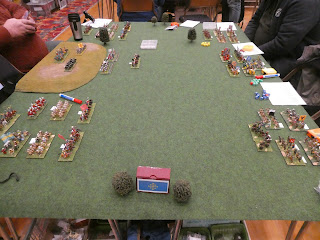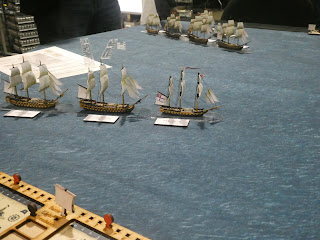Initially the show was cancelled as the club was having difficulty finding someone to organise it, however, Matt from the Pit Gaming Shop stepped in to take over. So, on a cold and frosty morning we set out over the Pennines to Leeds. The tables and chairs were all set up when we arrived so setting up our game was straightforward. Once the doors opened, it wasn't exactly a flood of people coming in, but sufficient to give a good atmosphere. A reasonable spread of traders were present and they seemed to be busy in the morning, but after lunch the usual decline set in.
We were putting on our usual 'Lion Rampant' participation game, this time a fictional clash from the 1396 Danube Crusade, which ended in the crushing defeat of the Crusader forces at Nicopolis.
 |
| Let battle commence: Crusaders on the right |
 |
| All that remained of the Crusader centre, about to be encircled |
The mounted knights and men at arms had been wiped out and only the foot knights remained and they faced four Janissary units. Losses on the flanks took the total of lost units to 8 and with over half of the army lost the Ottomans claimed victory.
After lunch we played through again and once again the knights fared badly. Even though they were only required to achieve a score of 3+ on two d6 they still contrived to fail a morale check and had to fall back. Coupled with repeated failures to charge (5+ required on two d6), they suffered from the repeated showers of arrows. Nevertheless, with defeat seemingly inevitable, a last desperate charge by the men at arms managed to inflict a casualty on the Sipahi of the Porte, who were led by the Ottoman army commander. There is a chance of killing a general involved in melee (double one is required on two d6), the Crusader player rolled the dice... double one. Victory dragged from the jaws of defeat!!
During the lunch break I managed to have a look at two nearby games.
Peterborough Wargames "What a Pirate"
These were taken before the group re-set for a game in the afternoon session.
East London with two games using the "Emperor of the Battlefield" rules
Many thanks to Andy, Bob, Steve and Will for helping with the game and to John, a willing volunteer who tackled our version of 'Lion Rampant'




















































